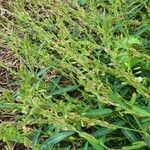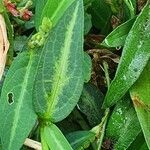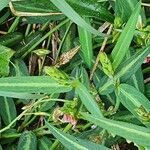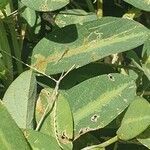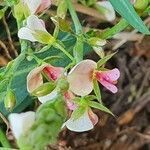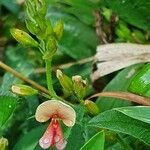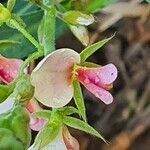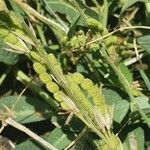A herb. It grows each year from seed. It is often woody at the base. It can lie over. The stems are hairy. The leaves have one leaflet. The leaflet is 1-2 cm long by 0.2-1.1 cm wide. The flowers are neat the tip opposite the leaves. The fruit are pods 1-1.5 cm long. There are 4-7 seeds and the pod is constricted between the seeds. The seeds are reddish brown or olive green. They are about 2 mm long by 1.8 mm wide and 1 mm deep. There are some subspecies.
Leaves 1-foliolate; leaflet 0.65–12.5 × 0.2–1.1 cm, oblong, linear or linear-lanceolate, acute and mucronulate at the apex, rounded or slightly cordate at the base, finely puberulous and with longer hairs on lower surface, slightly reticulate; petiole 2–6 mm long; petiolule 0.5–1 mm long; stipules 4–16 mm long, lanceolate.
Fruit 7–15 mm long, much constricted between the articles; articles 4–7, 1.5–3 × 2–3 mm, transversely elliptic, with strong close transverse ridges which join up here and there, shortly pubescent or puberulous.
Inflorescences terminal and leaf-opposed; peduncle 3 cm long; rhachis 3–30 cm long; pedicels 2–5(9) mm long; primary bracts 4–6 × 2 mm, elliptic, acuminate, deciduous; secondary bracts 1.5–2 mm long, linear.
Calyx puberulous or pubescent; tube 1–1.5 mm long; teeth 4–6 × 0.7–1.5 mm, lanceolate or narrowly triangular, at first slightly imbricate at the base, ciliate with white hairs or glabrous.
Standard salmon-coloured, red or mauve, 5–6 × 3–5 mm, obovate; wings and keel often pale, but margined and tipped with purple.
Stems pubescent, sometimes only in narrow longitudinal lines, or densely covered with spreading hairs.
Seeds reddish-brown or olive, compressed, 1.8–2.2 × 1.8 × 1–1.2 mm, rounded-rhomboid or ellipsoid.
Erect annual herb, sometimes procumbent, often somewhat woody at the base, 0.15–1.5 m tall.
Similar to the preceding species (Alysicarpus rugosus).
